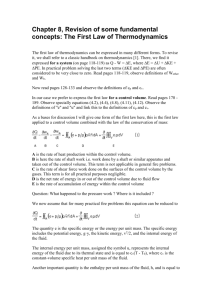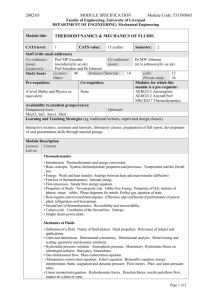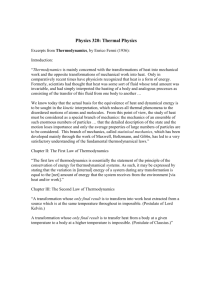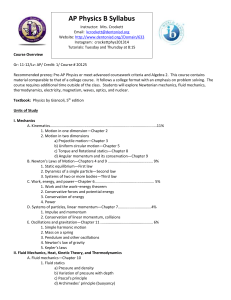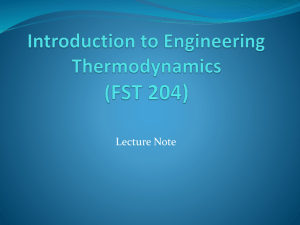SI_FTFS_4e_Chap01_lecture - Faculty of Mechanical Engineering
advertisement
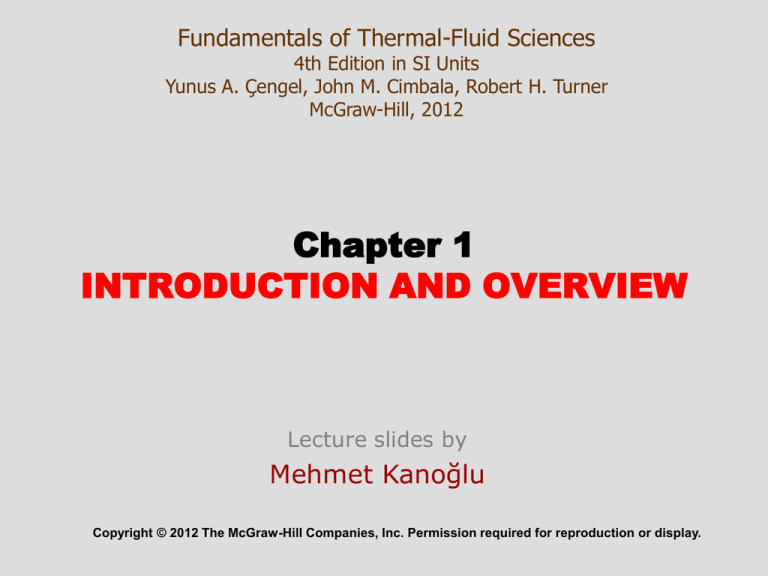
Fundamentals of Thermal-Fluid Sciences 4th Edition in SI Units Yunus A. Çengel, John M. Cimbala, Robert H. Turner McGraw-Hill, 2012 Chapter 1 INTRODUCTION AND OVERVIEW Lecture slides by Mehmet Kanoğlu Copyright © 2012 The McGraw-Hill Companies, Inc. Permission required for reproduction or display. Objectives • Be acquainted with the engineering sciences thermodynamics, heat transfer, and fluid mechanics, and understand the basic concepts of thermal-fluid sciences. • Be comfortable with the metric SI and English units. • Develop an intuitive systematic problem-solving technique. • Learn the proper use of software packages in engineering. • Develop an understanding of accuracy and significant digits in calculations. 2 1-1 INTRODUCTION TO THERMAL-FLUID SCIENCES • Thermal-fluid sciences: The physical sciences that deal with energy and the transfer, transport, and conversion of energy. • Thermal-fluid sciences are studied under the subcategories of thermodynamics heat transfer fluid mechanics 3 Application Areas of Thermal-Fluid Sciences 4 1-2 THERMODYNAMICS • Thermodynamics: The science of energy. • Energy: The ability to cause changes. • The name thermodynamics stems from the Greek words therme (heat) and dynamis (power). • Conservation of energy principle: During an interaction, energy can change from one form to another but the total amount of energy remains constant. • Energy cannot be created or destroyed. • The first law of thermodynamics: An expression of the conservation of energy principle. • The first law asserts that energy is a thermodynamic property. 5 • The second law of thermodynamics: It asserts that energy has quality as well as quantity, and actual processes occur in the direction of decreasing quality of energy. • Classical thermodynamics: A macroscopic approach to the study of thermodynamics that does not require a knowledge of the behavior of individual particles. Conservation of energy principle for the human body. • It provides a direct and easy way to the solution of engineering problems and it is used in this text. • Statistical thermodynamics: A microscopic approach, based on the average behavior of large groups of individual particles. • It is used in this text only in the supporting role. Heat flows in the direction of decreasing temperature. 6 1-3 HEAT TRANSFER • Heat: The form of energy that can be transferred from one system to another as a result of temperature difference. • Heat Transfer: The science that deals with the determination of the rates of such energy transfers and variation of temperature. • Thermodynamics is concerned with the amount of heat transfer as a system undergoes a process from one equilibrium state to another, and it gives no indication about how long the process will take. But in engineering, we are often interested in the rate of heat transfer, which is the topic of the science of heat transfer. 7 1-4 FLUID MECHANICS • Fluid mechanics: The science that deals with the behavior of fluids at rest (fluid statics) or in motion (fluid dynamics), and the interaction of fluids with solids or other fluids at the boundaries. • Fluid: A substance in the liquid or gas phase. • A solid can resist an applied shear stress by deforming, whereas a fluid deforms continuously under the influence of shear stress, no matter how small. Fluid mechanics deals with liquids and gases in motion or at rest. 8 The normal stress and shear stress at the surface of a fluid element. For fluids at rest, the shear stress is zero and pressure is the only normal stress. Deformation of a rubber block placed between two parallel plates under the influence of a shear force. The shear stress shown is that on the rubber—an equal but opposite shear stress acts on the upper plate. Unlike a liquid, a gas does not form a free surface, and it expands to fill the entire available space.9 1-5 IMPORTANCE OF DIMENSIONS AND UNITS • Any physical quantity can be characterized by dimensions. • The magnitudes assigned to the dimensions are called units. • Some basic dimensions such as mass m, length L, time t, and temperature T are selected as primary or fundamental dimensions, while others such as velocity V, energy E, and volume V are expressed in terms of the primary dimensions and are called secondary dimensions, or derived dimensions. • Metric SI system: A simple and logical system based on a decimal relationship between the various units. • English system: It has no apparent systematic numerical base, and various units in this system are related to each other rather arbitrarily. 10 Some SI and English Units Work = Force Distance 1 J = 1 N∙m 1 cal = 4.1868 J 1 Btu = 1.0551 kJ 11 A body weighing 60 kgf (600 N) on earth will weigh only slightly over 10 kgf (100 N) on the moon. W weight m mass g gravitational acceleration12 A typical match yields about one kJ of energy if completely burned. Specific weight : The weight of a unit volume of a substance. 13 Dimensional homogeneity All equations must be dimensionally homogeneous. Unity Conversion Ratios All nonprimary units (secondary units) can be formed by combinations of primary units. Force units, for example, can be expressed as They can also be expressed more conveniently as unity conversion ratios as Unity conversion ratios are identically equal to 1 and are unitless, and thus such ratios (or their inverses) can be inserted conveniently into any calculation to properly convert units. 14 15 16 1-6 PROBLEM-SOLVING TECHNIQUE • Step 1: Problem Statement • Step 2: Schematic • Step 3: Assumptions and Approximations • Step 4: Physical Laws • Step 5: Properties • Step 6: Calculations • Step 7: Reasoning, Verification, and Discussion 17 18 19 Engineering Software Packages 20 EES (Engineering Equation Solver) (Pronounced as ease) EES is a program that solves systems of linear or nonlinear algebraic or differential equations numerically. It has a large library of built-in thermodynamic property functions as well as mathematical functions. Unlike some software packages, EES does not solve engineering problems; it only solves the equations supplied by the user. 21 A Remark on Significant Digits In engineering calculations, the information given is not known to more than a certain number of significant digits, usually three digits. Consequently, the results obtained cannot possibly be accurate to more significant digits. Reporting results in more significant digits implies greater accuracy than exists, and it should be avoided. 22 Summary • Introduction to Thermal-Fluid Sciences Application areas of thermal-fluid sciences • • • • Thermodynamics Heat Transfer Fluid Mechanics Importance of Dimensions and Units Some SI and English units Dimensional homogeneity Unity conversion ratios • Problem-Solving Technique Engineering Software Packages Engineering Equation Solver (EES) A Remark on Significant Digits 23
